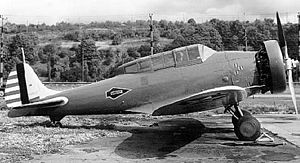Boeing P-29
| P-29/XF7B-1 | |
|---|---|
 |
|
| Boeing P-29 in its original configuration (U.S. Air Force photo) | |
| Role | Fighter |
| Manufacturer | Boeing |
| First flight | 20 January 1934 (Boeing Model 264) |
| Introduction | Cancelled |
| Primary users |
U.S. Army Air Corps U.S. Navy |
| Number built | 4 |
| Developed from | Boeing P-26 |
The Boeing P-29 and XF7B-1 were an attempt to produce a more advanced version of the highly successful P-26. Although slight gains were made in performance, the U.S. Army Air Corps and U.S. Navy did not order the aircraft.
The Boeing YP-29 originated as the Model 264, developed as a private venture under a bailment contract negotiated with the U.S. Army. Development of three prototypes was initiated in the interval between the testing of the XP-936 (P-26 prototype, company Model 248) and the delivery of the first P-26A (Model 266) to the U.S. Army.
The Model 264 was an updated and modernized P-26, differing in having fully cantilever wings, wing flaps, enclosed "greenhouse" canopy, and retractable undercarriage. The landing gear was similar to the Boeing Monomail, the main wheels retracting backwards about halfway into the wings. The fuselage and the tail were basically the same as those of the P-26. The 264 retained the proven 550 hp Pratt & Whitney R-1340-31 Wasp air-cooled radial, used in the P-26. The armament of one 0.30-cal and one 0.50 cal machine guns mounted in the fuselage sides and firing between the cylinder heads of the radial engine was the same as the P-26A.
The first Model 264 featured a long, narrow, sliding canopy, essentially a transparent continuation of the P-26's protective headrest, extending all the way to the windshield frame. The Wasp radial was enclosed in a full NACA cowling rather than the narrow Townend ring of the P-26.
One final variant was considered by Boeing, the Model 273, which was intended for the U.S. Navy as the XF7B-1. Aside from slight dimensional variations, military equipment carried, and the performance ratings of its Wasp engine, the naval fighter was very similar to its Army antecedents. Like the other variants, its enclosed cockpit was eventually modified into an open cockpit, which was considered more acceptable in the era.
The airplane made its maiden flight on 20 January 1934 and was flown to Wright Field for Army testing under the experimental military designation XP-940 five days later. During testing, the XP-940 achieved a maximum speed of 220 mph at 10,000 ft (354 km/h at 3,050 m). After testing, the XP-940 was returned to the factory in March for modifications. Due to the tight-fitting canopy and restricted pilot vision from the cockpit enclosure, Boeing reverted to an open cockpit design, retaining the long headrest all the way to the tail. The engine was replaced by a 600 hp (450 kW) R-1340-35 with a drag ring, similar to the P-26A's. It was also fitted with flaps, which the XP-940 lacked.
...
Wikipedia
